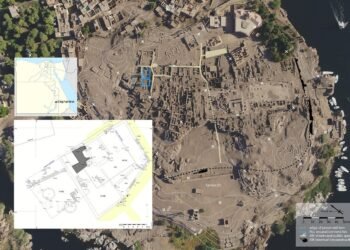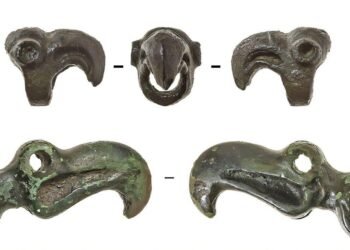Archaeologists from the Ephorate of Antiquities of Larissa have discovered architectural remains of a monumental building at the “Skiathas” site, specifically in an area where a marble threshold and parts of walls could be seen.
According to the Hellenic Ministry of Culture and Sport, the excavation findings suggest that the site is a sanctuary dating back to the Hellenistic period, specifically the 3rd to 2nd century BCE. This sanctuary is constructed using alabaster and local stone. The site, which has been supervised by archaeologist Nektaria Alexiou, has provided valuable insights into the past.
The discovery includes the remnants of a marble threshold, parts of walls, a statue pedestal, a section of a column, and a marble bank leg. Additionally, two marble heads of children, representing a girl and a boy, were unearthed at the site.
The ancient settlement at Skiathas covers an extensive area of 55 acres and features natural fortifications, such as a deep stream to the north, west, and south. This walled settlement is located on a low hill, connecting the Ossa mountain range to the north with the Pelion mountain range to the south. It also stretches eastward to the sea, with rocky shores along the northern Aegean, possibly indicating the presence of two natural ports.
Interestingly, this marks the first discovery of a building outside the city walls of this ancient settlement. In addition to the Hellenistic-era structure, a square tower from the Byzantine period has been investigated.
The ongoing research at Skiathas is expected to provide answers to significant archaeological questions about this coastal area, which is rich in antiquities. This discovery adds to the understanding of the cultural and historical importance of the region, showcasing the deep connections of the past to the present.
Excavations have also uncovered a variety of artifacts, including iron nails, an iron arrowhead, bronze rings, copper bottle pieces, lead objects, and Thessalian and Macedonian coins. The finds paint a picture of life in this area during the Hellenistic period.
In addition to the metal artifacts, numerous clay objects were discovered, including clay cloth weights, clay lamps, drinking containers, and remnants of commercial amphorae. Among the clay fragments were seal tiles inscribed with the names of ceramic workshop owners, further linking Skiathas to the ancient city of Magnesia Melivoia. This archaeological site has proven to be a treasure trove of historical and cultural significance.






















